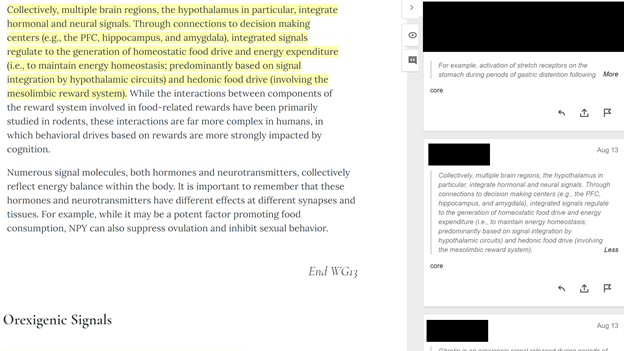6 Examples of Structured Renewable Assignments
Tagging an Open Textbook
Students tag a few paragraphs of an open textbook, using hypothes.is to mark spots that need ‘#fact check’ concepts that are ‘#core’ sections that ‘#needcontext’
Learners are given a list of tags and an assignment ranging from a few paragraphs to a chapter, with a number of tags they should apply. They then apply tags, with or without additional annotation.

Open Exam/Quiz Question Repository
A number of teachers have tested having students write quiz and exam questions, distractor choices, and contribute them to a repository. This is a relatively easy assignment to make highly structured, because it involves small ‘chunks’ of contribution, which can receive very specific feedback.
Examples from teachers in practice:
There have been some empirical studies of students writing test questions for themselves. Findings, encouragingly, include:
- Generally, students who participate in writing assessments perform better
- This improved performance holds when students are tested with tests they didn’t take part in writing.
Open Textbook Contribution Peer Review
In an Endocrinology course at UW, Jennifer White and Peter Wallis tested a peer review assignment that walked students through a structured rubric to evaluate and revise other students’ open learning contributions. Learners checked references, facts, clarity of text, and more.
We were particularly happy with these assignments, because they introduced students to the scholarly practice of peer review.
Glossary Entries
Students in our research suggested that they be involved in creating a glossary for an open textbook. This assignment design has a number of advantages: It involves relatively small contributions, for easier detailed feedback. It increases learner familiarity with key terms in the field. Student contributions are immediately useful to them and future students.
At this time, we don’t have good examples of applications of this assignment type.
Writing Introductory Materials
In fields with a relatively set textual corpus, like Robin DeRosa’s Early American Literature courses, introductory materials are a common form of academic writing. Giving students structured opportunities to write them helps the students understand the texts, their context, and translate those meanings into their own context, and that of other learners their age.
See DeRosa’s writing on the topic for more detail about her methods, it is a classic in Open Pedagogy and OER co-construction.
Early Feedback from Students on Structured Renewable Assignments
In our research with an Endocrinology course at UW, we (Peter Wallis and Jennifer White) found students were highly engaged and positive about tagging, peer review, and chapter re-write assignments. We used both surveys and focus groups to measure satisfaction and what elements worked best.
Other teachers, similarly, report very positive feedback from students, and high engagement. (Publication forthcoming)
